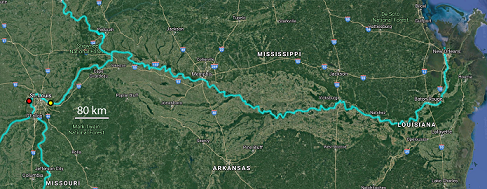Movement of the bull shark (Carcharhinus leucas) in the upper Mississippi River Basin, North America
DOI:
https://doi.org/10.47193/mafis.3422021010607Keywords:
bull shark, Carcharhinus leucas, biogeography, Illinois, Missouri, Mississippi River, Cryptic species, zooarchaeologyAbstract
Rare appearances of bull sharks (Carcharhinus leucas) in river systems and other freshwater ecosystems have been reported from five continents. The wide geographic range of this phenomenon, the physiological adaptations of this species to allow for movement into rivers, and a fossil record in the Miocene Epoch, all imply that this behavior has a long history. In the Mississippi River basin, however, only two specimens were captured in the river’s upper portion during the entire 20th century. Further historical, archeological, and paleontological records of these animals appearing farther than 500 km upstream from the Mississippi delta is almost nonexistent. Bull shark movements in the upper portions of this river are likely sufficiently rare or cryptic to avoid detection using historical, archaeological, paleontological, and modern fisheries conservation techniques. Deeper research into these sharks, and their historical biogeography is needed to better understand the relationship these large predators have to the freshwater ecosystems of the American mid-continent.
Downloads
References
Apolín J, González-Barba G, Martínez J. 2007. Seláceos del Mioceno superior de Quebrada Pajaritos (Piura, Perú). Sociedad Geológica del Perú, Publicación Especial. 6: 401-404.
Burr BM, Basile CM, Adams GL, Nicholson MC. 2004. Exotic aquatic and terrestrial animals in the Hoosier-Shawnee ecological assessment area. In: Thompson FR, editor. The Hoosier-Shawnee Ecological Assessment. St. Johns (MI): U.S. Department of Agriculture, Forest Service, North Central Research Station. p. 236-267.
Cameron B, Boreske JR. 1972. Clam borings in reworked whale skull, shark teeth and oysters: Miocene of Maryland and North Carolina. Geological Society of America. Abstracts. 4 (1): 7.
Cappetta H. 2012. Handbook of paleoichthyology. Vol. 3E. Chondrichthyes Mesozoic and Cenozoic Elasmobranchii: teeth. München: Verlag Dr. Freidrich Pfeil. 512 p.
Colvin GH. 2011. The presence, source and use of fossil shark teeth from Ohio archaeological sites. Ohio Archaeol. 61: 26-46.
Ebersole JA, Ebersole SM, Cicimurri DJ. 2017. The occurrence of early Pleistocene marine fish remains from the Gulf Coast of Mobile County, Alabama, USA. Palaeodiversity. 10: 97-115. DOI: https://doi.org/10.18476/pale.v10.a6
Ebert DA, Fowler SL, Compagno LJV. 2013. Sharks of the world. Princeton (NJ): Princeton University Press.
Elderkin CL, Klerks PL. 2004. Variation in thermal tolerance among three Mississippi River populations of the zebra mussel, Dreissena polymorpha. J Shellfish Res. 24: 221-226. DOI: https://doi.org/10.2983/0730-8000(2005)24[221:VITTAT]2.0.CO;2
Fowler SL, Reed TM, Dipper FA. 1997. Elasmobranch biodiversity, conservation, and management. Proceedings of the International Seminar and Workshop, Sabah, Malaysia, July 1997. Gland, Switzerland: The IUCN Species Survival Commission. https://portals.iucn.org/library/efiles/documents/ssc-op-025.pdf.
Gaussman P. 2018. Synopsis of global freshwater occurrences of the bull shark (Carcharhinus leucas Valenciennes 1839, Carcharhinidae) with comments on the geographical range. ResearchGate. [2018 June]. https://www.researchgate.net/profile/Peter-Gausmann/publication/325737350_Synopsis_of_global_freshwater_occurrences_of_the_bull_shark_Carcharhinus_leucas_VALENCIENNES_1839_Carcharhinidae_with_comments_on_the_geographical_range/links/5b20f4f4458515270fc6379d/Synopsis-of-global-freshwater-occurrences-of-the-bull-shark-Carcharhinus-leucas-VALENCIENNES-1839-Carcharhinidae-with-comments-on-the-geographical-range.pdf.
Hulbert RC, GS Morgan. 1989. Stratigraphy, paleoecology, and vertebrate fauna of the Leisey Shell Pit local fauna, early Pleistocene (Irvingtonian) of southwestern Florida. Papers in Florida Paleontology. 2: 1-19.
Iqbal M, Nurnawati E, Setiawan A, Dahlan Z, Yustian I. 2019a. First photographic inland records of bull shark Carcharinus leucas (Carchariniformes: Carcharinidae) in Sumatran waters, Indonesia. Ecol Montenegrina. 22: 171-176.
Iqbal M, Setiawan A, Yustian I. 2019b. First inland record of bull shark Carcharinus leucas (Carchariniformes: Carcharinidae) in Indonesian Borneo. Ecol Montenegrina. 22: 52-57.
Kaschner K, Kesner-Reyes K, Garilao C, Rius-Barile J, Rees T, Froese R. 2016. AquaMaps: predicted ranges for aquatic species. Version 08/2016. [accessed 2021 February]. https://www.aquamaps.org/.
Murphy JL. 1975. Shark tooth caches in Wayne County, Ohio. Ohio Archaeol. 25: 26-27.
Springer JW. 1980. An analysis of prehistoric food remains from the Bruly St. Martin Site, Louisiana, with a comparative discussion of Mississippi Valley faunal studies. MidCont J Archaeol. 5: 193-223.
Thomerson JE, Thorson TB, Hempel RL. 1977. The bull shark, Carcharhinus leucas, from the upper Mississippi River near Alton, Illinois. Copeia. 1977: 166-168. DOI: https://doi.org/10.2307/1443522
Worthen AH. 1882. Economical geology of Illinois. Springfield (IL): Illinois State Geological Survey. https://archive.org/details/economicalgeolog02wort.

Published
Issue
Section
License
Copyright (c) 2021 Ryan Shell, Nicholas Gardner

This work is licensed under a Creative Commons Attribution-NonCommercial-ShareAlike 4.0 International License.
Authors of articles published in Marine and Fishery Sciences retain copyright on their articles, except for any third-party images and other materials added by Marine and Fishery Sciences, which are subject to copyright of their respective owners. Authors are therefore free to disseminate and re-publish their articles, subject to any requirements of third-party copyright owners and subject to the original publication being fully cited. Visitors may also download and forward articles subject to the citation requirements. The ability to copy, download, forward or otherwise distribute any materials is always subject to any copyright notices displayed. Copyright notices must be displayed prominently and may not be obliterated, deleted or hidden, totally or partially.
This journal offers authors an Open Access policy. Users are allowed to read, download, copy, distribute, print, search, or link to the full texts of the articles, or use them for any other legal purpose within the Creative Commons 4.0 license (BY-NC-SA), without asking prior permission from the publisher or the author. This is in accordance with the BOAI definition of Open Access.
























